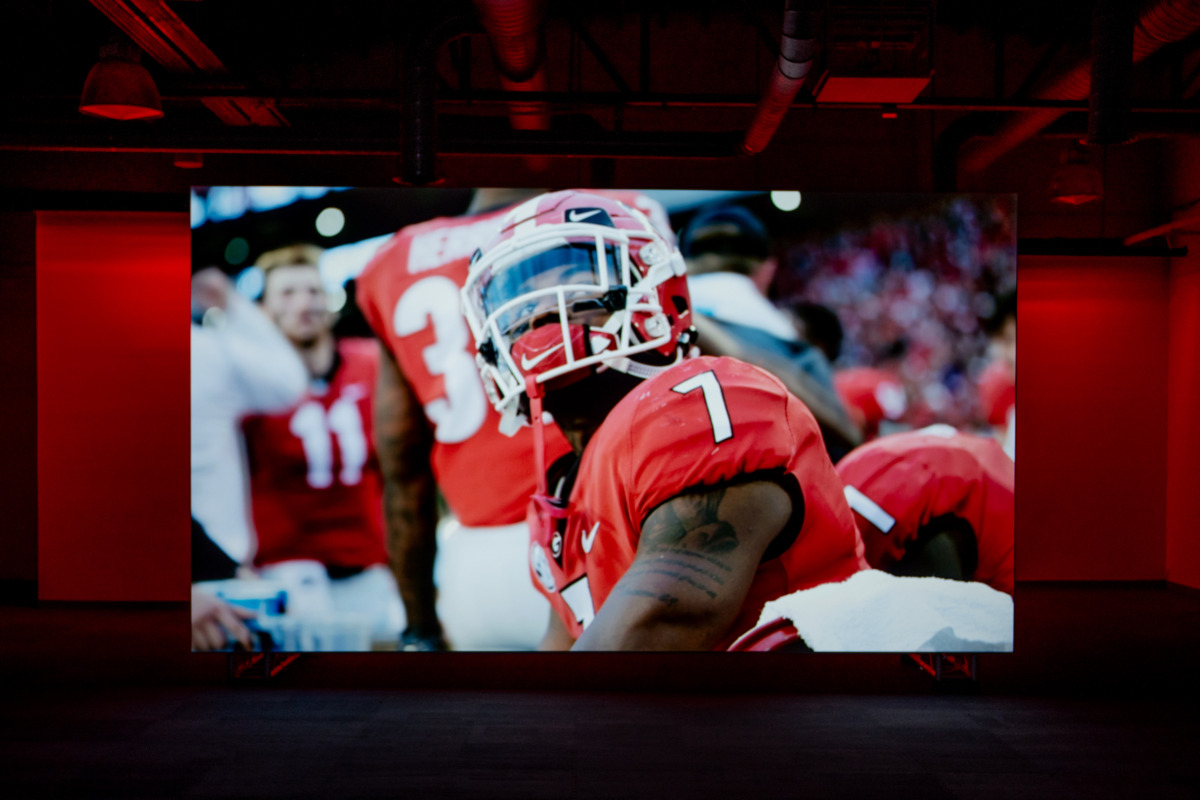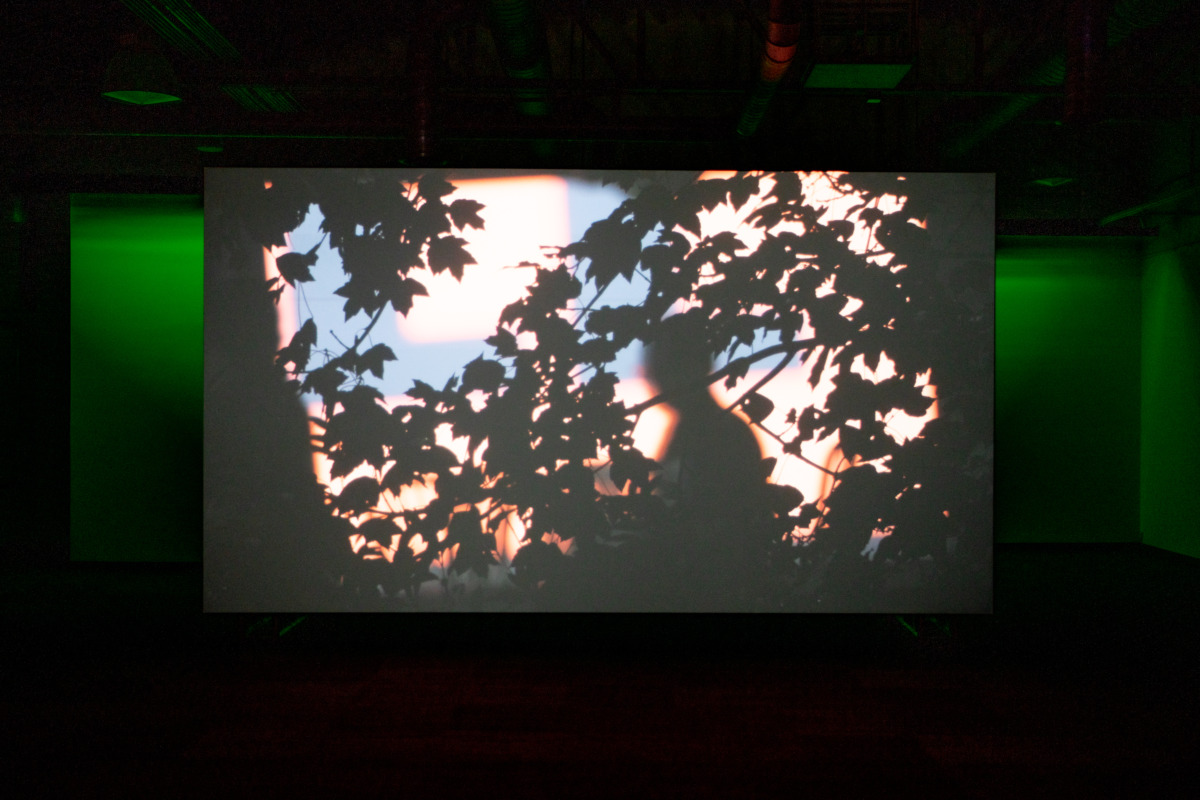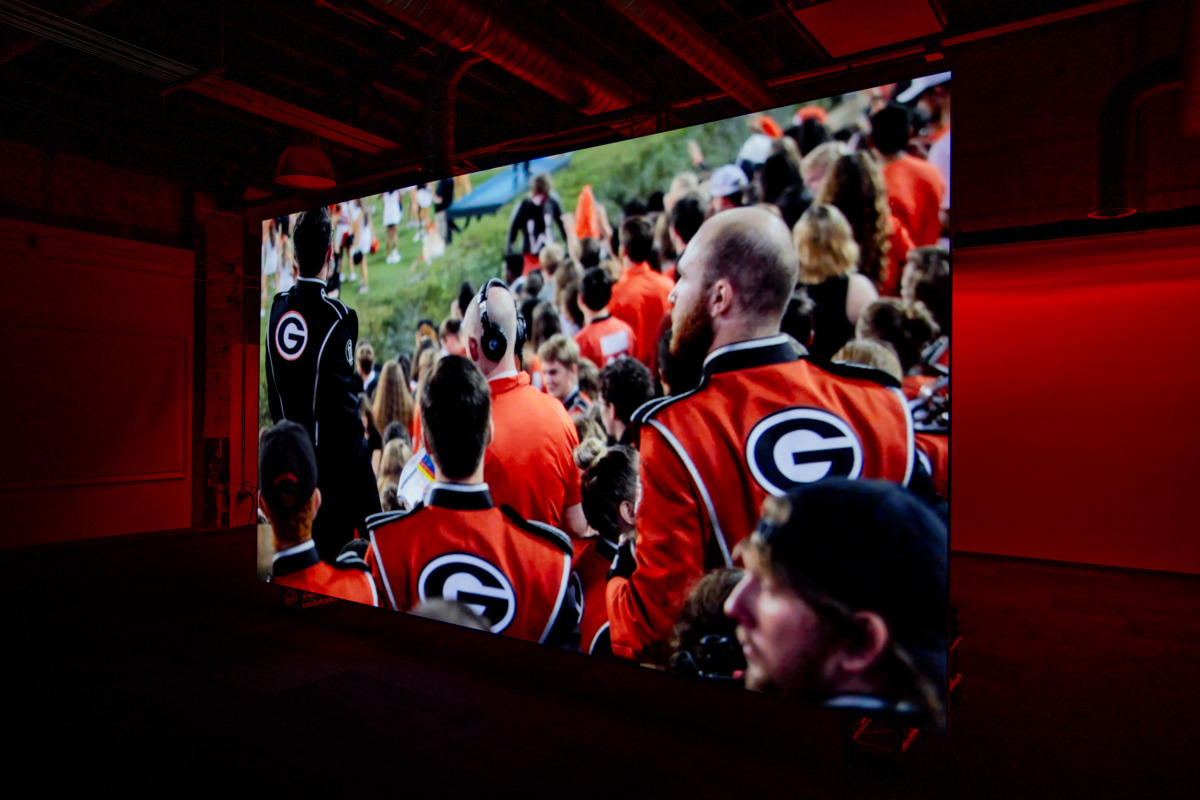
There is a moment at the start of Paul Pfeiffer’s single-channel video, Red Green Blue (2022), that I could return to repeatedly. Whistles blow. A timeout is called. The University of Kentucky’s offensive line raises their hulk-ish frames from their stances and turns in unison toward the sidelines. Between their blurry bodies, the camera focuses on one man, the University of Georgia’s Redcoat Marching Band director, Brett Bawcum. The break in play will be short-lived, fifteen seconds. Cut to an extreme closeup of Bawcum tapping the inside of his arm, the conductor fluidly articulating the intensity of the music to come. A few swift arm movements mark the band’s cues and entrances, and we are off.
An instantly familiar operatic horn version of Kayne West’s “Power” shakes our seats. Now, here is my favorite part. In a world that typically points its cameras only towards the field, Pfeiffer’s eight cameras are hyper-focused in the opposite direction. He frequently jumps in and out of closeups to deconstruct and recontextualize our perspective of the game. Cut to a young student blowing into the tuba with an unreal combination of pressure and control. His hair glistens with sweat, his bony knuckles gripping hard on the leadpipe. At the first instance of break, he unleashes a triumphant and celebratory smile like you rarely see. It’s too genuine. His arms shoot to the sky. His eyes scan his teammates, knowing that he shares this euphoria with those around him, this extended family. They all rock in unison. Someday, I hope to feel his joy. From that moment on, I’m in. I want to be part of this thing they have.

The Georgia Bulldogs are the kings of college football. After waiting forty-one years between championships, they have won back-to-back national titles in 2021 and 2022. Their head coach, Kirby Smart, is the highest-paid state employee (on average $11.25 million). Since 2018, they lost only one home game while playing in football’s toughest conference, the Southeastern Conference (SEC). In a city of 127,000, Sanford Stadium packs in 92,000 fans for each home game, boosting the nation’s third-longest consecutive sellout streak (52). Living in Atlanta, a city with three pro teams, it’s astonishing how all eyes remain on Athens.
How does a game that takes 60 minutes to play routinely take over 2.5 hours? Pfeiffer focuses on the mass entertainment aspect of the game, the moments between the moments. This video is a reminder that top-tier college football has little to do with those in the stadium but is often organized around the television broadcast. So, what happens during the pauses for injuries, penalties, TV timeouts, replies, challenges, and commercial advertising? This is when the Director of Fan Experience gets to shine.
When one team is better than the other, and the outcome is almost inevitable, how do we keep millions of viewers under the spell of the game? Like a scripted drama, the game is meticulously orchestrated by a figure in the control room, who shapes a cohesive story, creating a rollercoaster’s anticipation and nervous energy. Pfeiffer delves into the intricate web of individuals within the stadium who influence and shape the audience’s emotional reactions by instigating synchronized behaviors from the spectators.
In the film, there is a scene where everything seems to halt. A quick groan from the crowd is drowned out by the referee’s whistle. The band director lets his cohorts know the officials are checking for targeting, when a player leaves their feet to attack an opponent, subject to disqualification. Pfeiffer’s cameras aren’t where they should be. We are left to wonder, is a player down? Is the medical staff on the field? Players congregate, but unlike a traditional broadcast, we only see them from the thighs down. We compare protective gear, from pads to wraps, and the lineman wearing robotic red knee braces. Unlike many previous Pfeiffer videos where his abstractions produce a sense of transcendence with athletes levitating, their cleats are planted firmly in the ground. Behind all the pageantry in the stands, a heavy weight sits squarely on their unseen shoulders.

Suddenly, we watch the legs begin to bop as the p.a. system blares the Atlanta anthem, Crime Mob’s “Kunck If You Buck.” For the first time, the kids get to act like kids. This, too, is pre-programmed, cued up, and ready to fill any potential downtime. For the referee’s ruling on the field, Pfeiffer weaves in footage from ESPN. Even for such a brief time, it’s almost jarring to turn away from the stands and return to a conventional view, a blunt reminder that we are watching a live taping of a television show. The screen is split into three separate squares, awaiting the dramatic conclusion: The referee (the judge), the opposing coach (the adversary), and the opposing player (the condemned).
Throughout the video, Pfeiffer skillfully contrasts the experience inside the stadium, this site of reverence and awe, with the shots of the Oconee Hill Cemetery, just across E. Campus Road. The nineteenth century burial ground is a poignant reminder of the enduring racial divisions in the South, which persist even in matters of death. Since its inception, Oconee Hill maintained a policy of segregation as a resting place for enslaved African Americans and numerous Confederate soldiers (including four Confederate generals). 2015, the University of Georgia stirred controversy when historical evidence showed that their Baldwin Hall was built directly on a graveyard for the city’s enslaved community. In 2017, they moved the remains of 105 unknown bodies to a single grave in Oconee Hill Cemetery. Pfeiffer’s video shows the disparity between the cemetery’s lush nature and rugged rocks, the tombstones, often emblazed with the Dawgs logo, tucked below the solemn pines. This all sits in the shadows of Sanford Stadium’s fortress-like dull grey concrete walls. It’s difficult to miss the unease of the reverberations from the stadium’s thunderous cheers and the band’s boom echoing throughout the burial ground. Mixing with the imagery, the sounds undermine the fantasy of the game. Its customs and dress code are impossible to separate from the site’s geographical, historical, and cultural contexts.
Under Pfeiffer’s direction, sports feel like a ruse, a means to address pressing societal issues. We think of the SEC football as being deeply woven into the cultural fabric of this region and often hear it referred to as a great uniter that brings the nation together in times of separation. But these days, we conveniently forget that SEC football desegrated begrudgingly only after USC’s historic championship over the University of Alabama’s all-white team in 1970. The University of Georgia, still healing from its desegregation riot on campus in 1961, did not allow Black students to play football until 1971.
It’s difficult to be burdened by history as the clock ticks down and the lights lower. Pom-pom sparkle, players raise four fingers, and the horns kick in, playing Superman’s “Krypton Fanfare.” Even the greatest skeptics get the chills watching Dawgs fans wave their arms forward in unison, cell phone lights cutting through the suddenly dark stands. As the band seamlessly transitions to their rally song, “Glory, Glory,” Pfeiffer zooms out further and focuses on the once distant lights shining like florescent stars in the otherwise pitch-dark night. If the song sounds familiar, it’s because it is the refrain from the “Battle Hymn,” the renowned Union anthem during the Civil War. Throughout the film, Pfeiffer zooms in on the details, shining a light on the traditions reminding us that things often aren’t as they seem.





